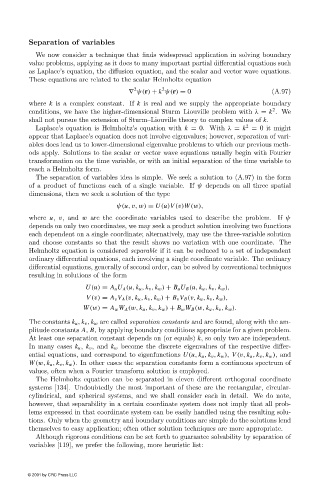Page 494 - Electromagnetics
P. 494
Separation of variables
We now consider a technique that finds widespread application in solving boundary
value problems, applying as it does to many important partial differential equations such
as Laplace’s equation, the diffusion equation, and the scalar and vector wave equations.
These equations are related to the scalar Helmholtz equation
2
2
∇ ψ(r) + k ψ(r) = 0 (A.97)
where k is a complex constant. If k is real and we supply the appropriate boundary
2
conditions, we have the higher-dimensional Sturm–Liouville problem with λ = k .We
shall not pursue the extension of Sturm–Liouville theory to complex values of k.
2
Laplace’s equation is Helmholtz’s equation with k = 0. With λ = k = 0 it might
appear that Laplace’s equation does not involve eigenvalues; however, separation of vari-
ables does lead us to lower-dimensional eigenvalue problems to which our previous meth-
ods apply. Solutions to the scalar or vector wave equations usually begin with Fourier
transformation on the time variable, or with an initial separation of the time variable to
reach a Helmholtz form.
The separation of variables idea is simple. We seek a solution to (A.97) in the form
of a product of functions each of a single variable. If ψ depends on all three spatial
dimensions, then we seek a solution of the type
ψ(u,v,w) = U(u)V (v)W(w),
where u, v, and w are the coordinate variables used to describe the problem. If ψ
depends on only two coordinates, we may seek a product solution involving two functions
each dependent on a single coordinate; alternatively, may use the three-variable solution
and choose constants so that the result shows no variation with one coordinate. The
Helmholtz equation is considered separable if it can be reduced to a set of independent
ordinary differential equations, each involving a single coordinate variable. The ordinary
differential equations, generally of second order, can be solved by conventional techniques
resulting in solutions of the form
U(u) = A u U A (u, k u , k v , k w ) + B u U B (u, k u , k v , k w ),
V (v) = A v V A (v, k u , k v , k w ) + B v V B (v, k u , k v , k w ),
W(w) = A w W A (w, k u , k v , k w ) + B w W B (w, k u , k v , k w ).
The constants k u , k v , k w are called separation constants and are found, along with the am-
plitude constants A, B, by applying boundary conditions appropriate for a given problem.
At least one separation constant depends on (or equals) k, so only two are independent.
In many cases k u , k v , and k w become the discrete eigenvalues of the respective differ-
ential equations, and correspond to eigenfunctions U(u, k u , k v , k w ), V (v, k u , k v , k w ), and
W(w, k u , k v , k w ). In other cases the separation constants form a continuous spectrum of
values, often when a Fourier transform solution is employed.
The Helmholtz equation can be separated in eleven different orthogonal coordinate
systems [134]. Undoubtedly the most important of these are the rectangular, circular-
cylindrical, and spherical systems, and we shall consider each in detail. We do note,
however, that separability in a certain coordinate system does not imply that all prob-
lems expressed in that coordinate system can be easily handled using the resulting solu-
tions. Only when the geometry and boundary conditions are simple do the solutions lend
themselves to easy application; often other solution techniques are more appropriate.
Although rigorous conditions can be set forth to guarantee solvability by separation of
variables [119], we prefer the following, more heuristic list:
© 2001 by CRC Press LLC

